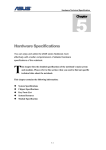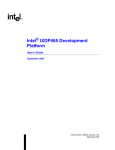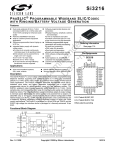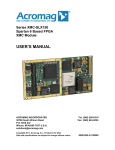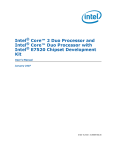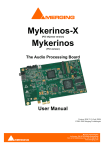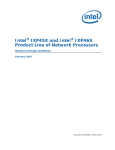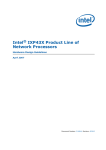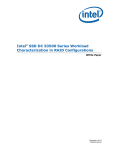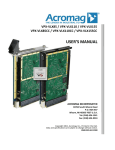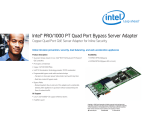Download PDF
Transcript
Intel® IXP435 Multi-Service Residential Gateway Reference Platform User’s Guide June 2007 Document Number: 316848; Revision: 001US INFORMATION IN THIS DOCUMENT IS PROVIDED IN CONNECTION WITH INTEL® PRODUCTS. NO LICENSE, EXPRESS OR IMPLIED, BY ESTOPPEL OR OTHERWISE, TO ANY INTELLECTUAL PROPERTY RIGHTS IS GRANTED BY THIS DOCUMENT. EXCEPT AS PROVIDED IN INTEL’S TERMS AND CONDITIONS OF SALE FOR SUCH PRODUCTS, INTEL ASSUMES NO LIABILITY WHATSOEVER, AND INTEL DISCLAIMS ANY EXPRESS OR IMPLIED WARRANTY, RELATING TO SALE AND/OR USE OF INTEL PRODUCTS INCLUDING LIABILITY OR WARRANTIES RELATING TO FITNESS FOR A PARTICULAR PURPOSE, MERCHANTABILITY, OR INFRINGEMENT OF ANY PATENT, COPYRIGHT OR OTHER INTELLECTUAL PROPERTY RIGHT. Intel products are not intended for use in medical, life saving, life sustaining, critical control or safety systems, or in nuclear facility applications. Legal Lines and Disclaimers Intel may make changes to specifications and product descriptions at any time, without notice. Designers must not rely on the absence or characteristics of any features or instructions marked “reserved” or “undefined.” Intel reserves these for future definition and shall have no responsibility whatsoever for conflicts or incompatibilities arising from future changes to them. The information here is subject to change without notice. Do not finalize a design with this information. The products described in this document may contain design defects or errors known as errata which may cause the product to deviate from published specifications. Current characterized errata are available on request. Contact your local Intel sales office or your distributor to obtain the latest specifications and before placing your product order. Copies of documents which have an order number and are referenced in this document, or other Intel literature, may be obtained by calling 1-800-5484725, or by visiting Intel’s Web Site. Intel processor numbers are not a measure of performance. Processor numbers differentiate features within each processor family, not across different processor families. See http://www.intel.com/products/processor_number for details. BunnyPeople, Celeron, Celeron Inside, Centrino, Centrino logo, Core Inside, FlashFile, i960, InstantIP, Intel, Intel logo, Intel386, Intel486, Intel740, IntelDX2, IntelDX4, IntelSX2, Intel Core, Intel Inside, Intel Inside logo, Intel. Leap ahead., Intel. Leap ahead. logo, Intel NetBurst, Intel NetMerge, Intel NetStructure, Intel SingleDriver, Intel SpeedStep, Intel StrataFlash, Intel Viiv, Intel vPro, Intel XScale, Itanium, Itanium Inside, MCS, MMX, Oplus, OverDrive, PDCharm, Pentium, Pentium Inside, skoool, Sound Mark, The Journey Inside, VTune, Xeon, and Xeon Inside are trademarks of Intel Corporation in the U.S. and other countries. *Other names and brands may be claimed as the property of others. Copyright © 2007, Intel Corporation. All rights reserved. Intel® IXP435 Multi-Service Residential Gateway Reference Platform User’s Guide 2 June 2007 Document Number: 316848; Revision: 001US User’s Guide—Intel® IXP435 Multi-Service Residential Gateway Reference Platform Contents 1.0 Introduction .............................................................................................................. 7 1.1 Purpose ............................................................................................................. 7 1.2 Intended Audience .............................................................................................. 7 1.3 Prerequisites....................................................................................................... 7 1.4 Related Documentation ........................................................................................ 8 1.5 Terminology ....................................................................................................... 9 2.0 Intel® IXP435 Multi-Service Residential Gateway Reference Platform Hardware Design ..................................................................................................................... 11 2.1 Overview of the Intel® IXP435 Multi-Service Residential Gateway Reference Platform. 11 2.2 Functional and Physical Layout of the Intel® IXP435 Multi-Service Residential Gateway Reference Platform ............................................................................................ 12 2.3 Component Placement ....................................................................................... 14 3.0 Design Solution Description..................................................................................... 16 3.1 Intel® IXP43X Product Line of Network Processors ................................................. 16 3.2 PCI Interface .................................................................................................... 18 3.2.1 PCI Clocking .......................................................................................... 18 3.3 Media Processor ................................................................................................ 19 3.4 Video Encoder................................................................................................... 23 3.5 Audio DAC........................................................................................................ 25 3.6 Expansion Bus Loading....................................................................................... 25 3.6.1 Expansion Bus Configuration Straps .......................................................... 25 3.6.2 Expansion Bus Clock Generation............................................................... 29 3.6.3 Expansion Bus Chip Selects ..................................................................... 29 3.7 Memory Subsystem ........................................................................................... 29 3.7.1 BootROM............................................................................................... 29 3.7.2 NAND Flash ........................................................................................... 29 3.7.3 DDRII Memory ....................................................................................... 30 3.8 MII Interface .................................................................................................... 31 3.8.1 Multi-Gang Jack ..................................................................................... 36 3.9 UTOPIA-2 Interface ........................................................................................... 37 3.10 USB 2.0 ........................................................................................................... 38 3.11 Serial Port ........................................................................................................ 38 3.11.1 Serial Port Pull-Ups/Pull-Downs ................................................................ 39 3.12 FXS and FXO Functions ...................................................................................... 39 3.12.1 FXS Ports .............................................................................................. 39 3.12.2 FXO Port and Failover Port....................................................................... 40 3.13 GPIO ............................................................................................................... 42 3.14 LED Indicators .................................................................................................. 43 3.15 Debug Circuitry ................................................................................................. 44 3.16 visionICE*/Raven* Emulator Interface ................................................................. 44 3.17 Additional JTAG Connectors ................................................................................ 45 3.18 Power .............................................................................................................. 46 3.19 Reset Logic....................................................................................................... 49 3.20 Clocking........................................................................................................... 50 4.0 Key Components of the Intel® IXP435 Multi-Service Residential Gateway Reference Platform .................................................................................................................. 51 5.0 Mechanical and PCB Stack Up .................................................................................. 52 6.0 Regulatory Guidelines ............................................................................................. 53 6.1 Environmental Guidelines ................................................................................... 53 6.2 Quality Requirements ........................................................................................ 53 June 2007 Document Number: 316848; Revision: 001US Intel® IXP435 Multi-Service Residential Gateway Reference Platform User’s Guide 3 Intel® IXP435 Multi-Service Residential Gateway Reference Platform—User’s Guide Updating the Intel® IXP435 Multi-Service Residential Gateway Reference Platform Flash Memory ..........................................................................................................54 A.1 Generic Flash Updating Using RedBoot* ................................................................54 A.2 Creating a Backup Copy of RedBoot .....................................................................55 A.3 Using RedBoot to Update RedBoot........................................................................56 A Figures 1 2 3 4 5 6 7 8 9 10 11 12 13 14 15 16 17 18 19 20 Intel® IXP435 Multi-Service Residential Gateway Reference Platform Functional Block Diagram ..........................................................................................13 Intel® IXP435 Multi-Service Residential Gateway Reference Platform Primary Side Placement.............................................................................................14 Intel® IXP435 Multi-Service Residential Gateway Reference Platform Bottom Side Placement .............................................................................................15 Intel® IXP43X Product Line Functional Block Diagram....................................................17 Philips* PNX1702 Media Processor Functional Block Diagram ..........................................20 PNX1702 and DDR Memory Topology ..........................................................................21 Video Encoder Functional Block Diagram......................................................................24 Audio DAC Block Diagram ..........................................................................................25 JP3 - Switch Location ................................................................................................28 DDRII Memory Topology ...........................................................................................31 NPE Function Connections..........................................................................................32 NPE-A/UTOPIA/MII Pin Switches Topology ...................................................................32 UTOPIA/MII Pin Switches Location ..............................................................................34 RJ-45 Jack with Integrated Magnetics..........................................................................36 Intel® IXP43X Product Line of Network Processors and SLIC/CODEC Topology ..................40 Intel® IXP43X Product Line of Network Processors and Voice/DAA Topology .....................41 Expansion Bus and LED Circuit Topology......................................................................44 JTAG Interface Locations ...........................................................................................46 Power Circuit Topology ..............................................................................................48 Reset Circuit Topology...............................................................................................50 Tables 1 2 3 4 5 6 7 8 9 10 11 12 13 14 15 16 17 18 19 20 Intel® IXP435 Multi-Service Residential Gateway Reference Platform Features Summary .... 8 Related Intel Documentation ....................................................................................... 8 Related External Documentation .................................................................................. 9 List of Terminology .................................................................................................... 9 IDSEL and GPIO Mapping on the PCI Devices ...............................................................18 PCI Host Slot Pin Assignments....................................................................................19 Supported Memory Configuration for Media Processor....................................................21 PNX1702 Configuration Strapping Boot Mode Settings ...................................................22 Configuration Strapping Options .................................................................................26 Configuration Strapping Clock Settings (JP3) ................................................................26 Expansion Bus Chip Select Assignments ......................................................................29 Supported DDRII Memory Configurations.....................................................................30 WAN Port Multi-function Switch Settings ......................................................................33 Intel® IXP435 Multi-Service Residential Gateway Reference Platform MII Mezzanine Connector Pin Definition ...........................................................................................................35 Utopia Mezzanine Connector Pin Definition ...................................................................37 Serial Port DB-9 Connector Pin Definitions ...................................................................39 Serial Port Resistors..................................................................................................39 Ethernet/FXS and FXO Control ...................................................................................42 Intel® IXP43X Product Line of Network Processors GPIO Assignment ...............................42 LED Indicators .........................................................................................................43 Intel® IXP435 Multi-Service Residential Gateway Reference Platform User’s Guide 4 June 2007 Document Number: 316848; Revision: 001US User’s Guide—Intel® IXP435 Multi-Service Residential Gateway Reference Platform 21 22 23 24 25 26 27 Ethernet LED Indicators ............................................................................................ 43 JTAG Connectors...................................................................................................... 45 Additional JTAG Connectors ....................................................................................... 45 Power Consumption Estimation .................................................................................. 48 Overview of the Key Components............................................................................... 51 PCB Stack Up .......................................................................................................... 52 Environmental Ranges .............................................................................................. 53 June 2007 Document Number: 316848; Revision: 001US Intel® IXP435 Multi-Service Residential Gateway Reference Platform User’s Guide 5 Intel® IXP435 Multi-Service Residential Gateway Reference Platform—User’s Guide Revision History Date Revision June 2007 001 Description Initial release Intel® IXP435 Multi-Service Residential Gateway Reference Platform User’s Guide 6 June 2007 Document Number: 316848; Revision: 001US User’s Guide-Intel® IXP435 Multi-Service Residential Gateway Reference Platform 1.0 Introduction 1.1 Purpose This document provides detailed design information for the Intel® IXP435 Multi-Service Residential Gateway Reference Platform. The IXP435 reference platform includes the basic blocks of an Intel® IXP43X Product Line of Network Processor-based system, DDR memory, PCI, and connectors through which UTOPIA level 2, MII, FXS, FXO, T1/E1 and power devices are connected. Several mezzanine cards designed (used in IXDP465 platform) in conjunction with the IXP435 multi-service residential gateway reference platform plug-in through the UTOPIA level 2 or MII connector. 1.2 Intended Audience The intended audience for this document includes hardware architects and developers who are developing both hardware and software for applications based on the Intel® IXP43X Product Line. The IXP435 reference platform is designed to meet the market requirements for a flexible customer-oriented platform. This platform demonstrates the capabilities of the IXP43X product line of network processors in a system and enables software development of the IXP43X product line of network processors. Customers can base their designs on portions of the IXP435 reference platform design. 1.3 Prerequisites The Intel® IXP435 Multi-Service Residential Gateway Reference Platform supports all available features of the Intel® IXP43X Product Line of Network Processors. Many features, such as the network processor engine (NPE) functions, are enabled by a specific revision of the Intel-supplied software. Refer to Table 2, “Related Intel Documentation” on page 8 for a list of hardware, software, and platform documents that will assist in the development process. In particular, the following documents provide details on available features: • Intel® IXP43X Product Line of Network Processors Datasheet has a complete list of available product features. • Intel® IXP400 Software Programmer’s Guide provides information on the features that are enabled in a particular software release. The IXP435 reference platform features that require enabling by software supplied by Intel are summarized in Table 1. June 2007 Document Number: 316848; Revision: 001US Intel® IXP435 Multi-Service Residential Gateway Reference Platform User’s Guide 7 Intel® IXP435 Multi-Service Residential Gateway Reference Platform-User’s Guide Table 1. Intel® IXP435 Multi-Service Residential Gateway Reference Platform Features Summary Features that do not require enabling software Features that require enabling software from Intel Intel XScale® Processor -- up to 667 MHz Encryption/Authentication (AES/AES-CCM/3DES/DES/ SHA-1/SHA-256/SHA-384/SHA-512/MD-5 PCI v. 2.2 33 MHz (Host/Option) One High-Speed Serial (HSS) interface Two USB 2.0 Host Controller Two Network Processor Engines (NPEs) DDRII/DDRI SDRAM interface Up to two MII interfaces Slave Interface Expansion bus One UTOPIA Level 2 interface One UART Internal Bus Performance Monitoring Unit 16 GPIOs Four internal timers Synchronous Serial Protocol (SSP) port Note: It is recommended that users have access to the documents listed in Table 2 and refer to them when necessary. This document does not explore the IXP43X product line internal architecture, but describes the processor’s interfaces to peripherals that are used on the IXP435 reference platform. Schematics and a bill of materials are available in the IXP435 reference platform Documentation Kit (zip file) that can be obtained through your local Intel sales representative. 1.4 Related Documentation Table 2 and Table 3 list the documentation from Intel and other sources that provide additional information for the development of hardware and software based on the IXP43X product line. Table 2. Related Intel Documentation (Sheet 1 of 2) Title Intel® IXP435 Multi-Service Residential Gateway Reference Platform Documentation Kit Document # Location N/A Through your local Intel sales representative Intel® IXP43X Product Line of Network Processors Developer’s Manual 316843 Through your local Intel sales representative Intel® IXP43X Product Line of Network Processors Datasheet 316842 Through your local Intel sales representative Intel® IXP400 Software Programmer’s Guide 252539 IXP4XX Documentation Web Page† Intel® IXP400 Software Specification Update 307310 IXP4XX Documentation Web Page† Designing Embedded Networking Applications Essential Insights for Developers of Intel® IXP4XX Network Processor Systems N/A http://www.intel.com/intelpress/ sum_ixp4.htm NX1702 Nexperia Media Processor of Philips* N/A http:// www.semiconductors.philips.com † This document is available at: http://www.intel.com/design/network/products/npfamily/docs/ ixp4xx.htm Intel® IXP435 Multi-Service Residential Gateway Reference Platform User’s Guide 8 June 2007 Document Number: 316848; Revision: 001US User’s Guide-Intel® IXP435 Multi-Service Residential Gateway Reference Platform Table 2. Related Intel Documentation (Sheet 2 of 2) Document # Title Intel® IXP42X Product Line of Network Processors and IXC1100 Control Plane Processor: Customizing RedBoot* Application Note 254308 Intel® IXDP465 Development Platform User’s Manual Intel® XScale™ Core Developer’s Manual † Table 3. Location IXP4XX Documentation Web Page† IXP4XX Documentation Web Page† 273473 IXP4XX Documentation Web Page† This document is available at: http://www.intel.com/design/network/products/npfamily/docs/ ixp4xx.htm Related External Documentation Title and Revision PCI Bus Specification, Rev. 2.2 1.5 Location http://www.pcisig.com/ MiniPCI Specification, 1.0 http://www.pcisig.com/ UTOPIA Level 2 Specification, Revision 1.0 http://www.atmforum.com/ Universal Serial Bus Specification, Revision 1.1 http://www.usb.org/ JEDEC Double Data Rate (DDR) SDRAM Specification, JESD79D http://www.jedec.org Terminology Table 4 lists the acronyms and common terms used in this manual. Table 4. List of Terminology (Sheet 1 of 2) Acronym Description ADSL Asymmetric Digital Subscriber Line Assert Logically active value of a signal or bit ATM Asynchronous Transfer Mode CPE Customer Premise Equipment DDR Double-Data Rate DMA Direct Memory Access DSL Digital Subscriber Line E1 Euro 1 trunk line FXO Foreign Exchange Office FXS Foreign Exchange Subscriber GPIO General-Purpose Input/Output HSS High-Speed Serial (port) IP Internet Protocol IXP Internet Exchange Processor LAN Local Area Network LSB Least-Significant Byte MAC Media Access Controller MDIO Management Data Input/Output mezzanine card A circuit board that attaches to the development platform baseboard and provides additional functionality. Mezzanine cards may be stackable. Also called daughtercard. June 2007 Document Number: 316848; Revision: 001US Intel® IXP435 Multi-Service Residential Gateway Reference Platform User’s Guide 9 Intel® IXP435 Multi-Service Residential Gateway Reference Platform-User’s Guide Table 4. List of Terminology (Sheet 2 of 2) Acronym Description MII Media-Independent Interface MSB Most-Significant Byte NPE Network Processor Engine PCI Peripheral Component Interface PHY Physical Layer (Layer 1) Interface Reserved A field that may be used by an implementation. Software should not modify reserved fields or depend on any values in reserved fields. RX Receive (HSS is receiving from off-chip) SDRAM Synchronous Dynamic Random Access Memory T1 Type 1 trunk line TX Transmit (HSS is transmitting off-chip) UART Universal Asynchronous Receiver-Transmitter UTOPIA Universal Test and Operation PHY Interface for ATM DVI Digital Video Interface CVBS Composite Video Baseband Signal LCD Liquid Crystal Display CCIR 656 CCIR Recommendation 656 WAN Wide-Area Network §§ Intel® IXP435 Multi-Service Residential Gateway Reference Platform User’s Guide 10 June 2007 Document Number: 316848; Revision: 001US User’s Guide-Intel® IXP435 Multi-Service Residential Gateway Reference Platform 2.0 Intel® IXP435 Multi-Service Residential Gateway Reference Platform Hardware Design This chapter provides detailed design information of all interfaces, components and features contained on the Intel® IXP435 Multi-Service Residential Gateway Reference Platform. The Intel® IXP43X Product Line of Network Processors is positioned to enable both cost sensitive Gateways and Converged Access Platforms (CAP). The platform has integrated SLIC codecs and DAA circuitry for VoIP and Philips* PNX1702 Nexperia media processor to support media centric applications such as triple-play. 2.1 Overview of the Intel® IXP435 Multi-Service Residential Gateway Reference Platform Figure 1 shows the block diagram of the IXP435 reference platform. The IXP435 reference platform comprises the following: • Memory subsystem • Networking subsystem • I/O subsystem • Power and reset subsystem • VoIP subsystem • Media subsystem The following sections describe the high level design of each subsystem respectively. • Intel® IXP43X Product Line of Network Processors • Media processor (Philips* PNX1702) • NOR Flash Memory (16 MB for IXP43X network processors) • NAND Flash Memory (64 MB for IXP43X network processors) • DDRII (128 MB for IXP43X network processors) • DDR Memory (64 MB for Media processor) • Video encoder (Philips* SAA7104H) • Audio DAC (Philips* UDA1334) • Video decoder (Philips* SAA7118) • Audio ADC (Philips* UDA1361) • Two SLIC/CODEC (Silicon Laboratories* Si3216 and Si3201) • Voice/Data DAA (Silicon Laboratories* Si3050 and Si3019) • Ethernet Switch (Kendin* 8995M) • USB 2.0 host connector (Two ports) • Two Mini-PCI slots June 2007 Document Number: 316848; Revision: 001US Intel® IXP435 Multi-Service Residential Gateway Reference Platform User’s Guide 11 Intel® IXP435 Multi-Service Residential Gateway Reference Platform-User’s Guide • One PCI Slot • One 120 pin MII connector • One 120 pin UTOPIA connector • Infrared remote control (use GPIO of IXP43X network processors) • S-Video, composite video and YCbCr/YPbPr for Video outputs • S-Video, and composite video for Video inputs • I2S and S/PDIF stereo audio outputs and input • Two JTAG (for IXP43X network processors and Media processor) • Two FXS RJ11 Port (VoIP function) • One FXO RJ11 Port • One 10/100 Mbps Ethernet port for WAN • Four 10/100 Mbps Ethernet ports for LAN • One 2KByte EEPROM for Media processor • One Serial port for debug used Mezzanine cards that are optional and that can be purchased separately include: • Intel® IXPDSM465 ADSL UTOPIA level 2 mezzanine card • Intel® IXPVM465 Analog Voice mezzanine card (4-FXS, 1-FXO) • Intel® IXPFRM465 Quad T1/E1 mezzanine card • Intel® IXPETM465 Ethernet PHY mezzanine cards The listed mezzanine cards have the same design as the one for the Intel® IXDP465 Development Platform. Note: This document will not describe information on the above mezzanine cards. Refer to the Intel® IXDP465 Development Platform User’s Guide for features and description of the mezzanine card hardware design. 2.2 Functional and Physical Layout of the Intel® IXP435 Multi-Service Residential Gateway Reference Platform The connections between the devices on the baseboard and mezzanine cards are shown in Figure 1. Details of the devices are described in the following sections . Intel® IXP435 Multi-Service Residential Gateway Reference Platform User’s Guide 12 June 2007 Document Number: 316848; Revision: 001US Intel® IXP435 Multi-Service Residential Gateway Reference Platform-User’s Guide Figure 1. Intel® IXP435 Multi-Service Residential Gateway Reference Platform Functional Block Diagram June 2007 Document Number: 316848; Revision: 001US Intel® IXP435 Multi-Service Residential Gateway Reference Platform User’s Guide 13 Intel® IXP435 Multi-Service Residential Gateway Reference Platform-User’s Guide 2.3 Component Placement The component layout of the Intel® IXP43X Product Line of Network Processors is shown in Figure 2 and Figure 3. Figure 2. Intel® IXP435 Multi-Service Residential Gateway Reference Platform Primary Side Placement SW HW IR_LED (debug only ) NAND Flash Mini-PCI_1 P C I J3 NOR TSOP DDR II USB USB LED Console port Reset Reset J3 /P30 NOR BGA Intel® IXP435 Network Processor DDR II RJ-45 RJ-45 RJ-45 RJ-45 RJ-45 SW OSC SW SW JTAG FXO CODEC Circuit FXS CODEC Circuit FXS CODEC Circuit Video Decoder Audio ADC RJ11 RJ11 S/PDIF in Audio DAC MIC DDR A udio in Video Encoder JTAG Out CVBS S-Video POWER Circuit DDR In Aud io in SW SW S/PDIF out G Aud io o ut CVBS B A udio out S-Video R Po wer J ack RJ11 PNX 1702 KENDIN KS8995M Power Switch B6516 -01 June 2007 Document Number: 316848; Revision: 001US Intel® IXP435 Multi-Service Residential Gateway Reference Platform User’s Guide 14 User’s Guide-Intel® IXP435 Multi-Service Residential Gateway Reference Platform Figure 3. Intel® IXP435 Multi-Service Residential Gateway Reference Platform Bottom Side Placement §§ June 2007 Document Number: 316848; Revision: 001US Intel® IXP435 Multi-Service Residential Gateway Reference Platform User’s Guide 15 Intel® IXP435 Multi-Service Residential Gateway Reference Platform-User’s Guide 3.0 Design Solution Description 3.1 Intel® IXP43X Product Line of Network Processors The Intel® IXP435 Multi-Service Residential Gateway Reference Platform is populated with 667 MHz IXP43X network processors. Jumpers are provided to configure the default core execution speed through the hardware strapping configurations. A 33.33 MHz oscillator acts as the input clock signal to the IXP43X network processors. The high-level view of the IXP43X network processors is shown in Figure 4. Intel® IXP435 Multi-Service Residential Gateway Reference Platform User’s Guide 16 June 2007 Document Number: 316848; Revision: 001US User’s Guide-Intel® IXP435 Multi-Service Residential Gateway Reference Platform Figure 4. Intel® IXP43X Product Line Functional Block Diagram HSS UTOPIA2/ MII NPE A MII North AHB 133.32 MHz x 32 bits NPE C High Speed UART 921 Kbaud North AHB Arbiter Queue Status Bu s SSP APB 6 6.66 MHz x 32 bits AES/ 3DES/ DES/ SHA/ MD-5 16 GPIO GPIO IBPMU AHB Slave/APB Master BRIDGE QUEUE MANAGER AHB/ AHB BRIDGE South AHB 133.32 MHz x 32 bits South AHB Arbiter Timers USB Port Host Controller USB Port Host Controller Version 2.0 Version 2.0 UTMI UTMI 2.0 PHY 2 .0 PHY Expansion Bus Controller 8/16 bit 80 MHz PCI Controller 16/32 Bits + ECC DDR 266/ DDRII 400 DDRII/ I MEMORY CONTROLLER UNIT 266/ 400 MPI 133.32 MHz/ 200 MHz x 64 bits Interrupt Controller ® Intel XScale Processor 32-bit 33 MHz 32 KB I - CACHE 32 KB D - CACHE 2 KB MINI D - CACHE 266/400/533/667 MHz Master on South AHB Bus Arbiters Master on North AHB Slave Only AHB Slave /APB Master B6514-01 June 2007 Document Number: 316848; Revision: 001US Intel® IXP435 Multi-Service Residential Gateway Reference Platform User’s Guide 17 Intel® IXP435 Multi-Service Residential Gateway Reference Platform-User’s Guide 3.2 PCI Interface The IXP435 reference platform supports the following four PCI devices as shown in Figure 1. • PCI Device #0: Media Processor • PCI Device #1: Mini-PCI #1 connector • PCI Device #2: Mini-PCI #2 connector • PCI Device #3: PCI Slot The IXP43X network processors act as the PCI host and all other devices act as PCI targets. The IXP435 reference platform supports only PCI 33 MHz bus operation with PCI 2.2 compliance. The IXP435 reference platform supports two external 32-bit Mini-PCI devices (3.3V only) and allows capabilities such as wireless LAN (for example, 802.11 a/b/g) and PCI version 2.2 is used. Table 5 describes the IDSEL mapping and GPIO mapping on the PCI devices of the IXP435 reference platform. The IDSEL signals are connected to the PCI_AD bus and these GPIO pins are for interrupt function. See the following tables for pin assignment details: Table 5. 3.2.1 IDSEL and GPIO Mapping on the PCI Devices SLOT ID Device Interrupt GPIO IDSEL Slot 0 Media Processor PNX1702 GPIO11 PCI_AD31 Slot 1 Mini-PCI #1 GPIO10 PCI_AD30 Slot 2 Mini-PCI #2 GPIO9 PCI_AD29 Slot 3 PCI slot GPIO8 PCI_AD28 PCI Clocking The 33 MHz is generated by the IXP43X network processors through the GPIO 14 and a four-port zero delay buffer (Cypress CY2305*) drives the four PCI devices’ clocks and the network processor PCI clock. Intel® IXP435 Multi-Service Residential Gateway Reference Platform User’s Guide 18 June 2007 Document Number: 316848; Revision: 001US User’s Guide-Intel® IXP435 Multi-Service Residential Gateway Reference Platform Table 6. PCI Host Slot Pin Assignments Pin Signal Pin Signal Pin Signal Pin Signal A1 PCI_HST_TRST_N0 A33 3.3 V B1 PCI_-12V_N0 B33 PCI_HST_CBE_N2 A2 12.0 V A34 PCI_HST_FRAME_N B2 PCI_HST_TCK0 B34 GND A3 PCI_HST_TMS0 A35 GND B3 GND B35 PCI_HST_IRDY_N A4 PCI_HST_TDI0 A36 PCI_HST_TRDY_N B4 PCI_HST_TDO0 B36 3.3 V A5 5.0 V A37 GND B5 5.0 V B37 PCI_HST_DEVSEL_N A6 PCI_HST_INTA_N A38 PCI_HST_STOP_N B6 5.0 V B38 GND A7 PCI_HST_INTC_N A39 3.3 V B7 PCI_HST_INTB_N B39 PCI_HST_LOCK_N A8 5.0 V A40 PCI_HST_SMBCLK0 B8 PCI_HST_INTD_N B40 PCI_HST_PERR_N A9 - A41 PCI_HST_SMBDAT0 B9 PCI_HST_PRSNT1_N0 B41 3.3 V A10 3.3 V A42 GND B10 - B42 PCI_HST_SERR_N A11 - A43 PCI_HST_PAR B11 PCI_HST_PRSNT2_N0 B43 3.3 V A14 - A44 PCI_HST_AD15 B14 - B44 PCI_HST_CBE_N1 A15 PCI_HST_RST_N A45 3.3 V B15 GND B45 PCI_HST_AD14 A16 3.3 V A46 PCI_HST_AD13 B16 PCI_HST_CLK0 B46 GND A17 PCI_HST_GNT_N0 A47 PCI_HST_AD11 B17 GND B47 PCI_HST_AD12 A18 GND A48 GND B18 PCI_HST_REQ_N0 B48 PCI_HST_AD10 A19 - A49 PCI_HST_AD9 B19 3.3 V B49 PCI_HST_M66EN0 A20 PCI_HST_AD30 A50 GND B20 PCI_HST_AD31 B50 GND A21 3.3 V A51 GND B21 PCI_HST_AD29 B51 GND A22 PCI_HST_AD28 A52 PCI_HST_CBE_N0 B22 GND B52 PCI_HST_AD8 A23 PCI_HST_AD26 A53 3.3 V B23 PCI_HST_AD27 B53 PCI_HST_AD7 A24 GND A54 PCI_HST_AD6 B24 PCI_HST_AD25 B54 3.3 V A25 PCI_HST_AD24 A55 PCI_HST_AD4 B25 3.3 V B55 PCI_HST_AD5 A26 PCI_HST_IDSEL0 A56 GND B26 PCI_HST_CBE_N3 B56 PCI_HST_AD3 A27 3.3 V A57 PCI_HST_AD2 B27 PCI_HST_AD23 B57 GND A28 PCI_HST_AD22 A58 PCI_HST_AD0 B28 GND B58 PCI_HST_AD1 A29 PCI_HST_AD20 A59 3.3 V B29 PCI_HST_AD21 B59 3.3 V A30 GND A60 PCI_HST_REQ64_N0 B30 PCI_HST_AD19 B60 PCI_HST_ACK64_N0 A31 PCI_HST_AD18 A61 5.0 V B31 3.3 V B61 5.0 V A32 PCI_HST_AD16 A62 5.0 V B32 PCI_HST_AD17 B62 5.0 V 3.3 Media Processor The audio/video function is controlled by PNX1702 Nexperia Media Processor of Philips*, which interfaces with the IXP43X network processors through the PCI interface. The PNX1702 Media Processor is a complete Audio/Video/Graphics system on a chip that contains a high-performance 32-bit VLIW processor, the TriMedia* TM3260. The TriMedia* TM3260 is capable of software video and audio signal processing, and general purpose control processing. It is capable of running a pSOS* operating system with real-time signal processing tasks in a single programming and task scheduling environment. An abundance of interfaces make the PNX1702 suitable for networked June 2007 Document Number: 316848; Revision: 001US Intel® IXP435 Multi-Service Residential Gateway Reference Platform User’s Guide 19 Intel® IXP435 Multi-Service Residential Gateway Reference Platform-User’s Guide audio/visual products. The processor is assisted by several image and video processing accelerators that support image scaling and compositing. The high-level view of the PNX1702 Media Processor is shown in Figure 5. Figure 5. Philips* PNX1702 Media Processor Functional Block Diagram The Video/data in function is provided on a connector for S-Video and CVBS input. The Video/data out function supports S-Video, Component, DVI, CVBS, CCIR 656 and LCD operation. The CVBS and S-Video OUT and Y/Cb/Cr are provided on a connector plate provided with the board. An SPDIF output unit outputs a high-speed serial data stream, primarily used to transmit digital SPDIF-formatted audio data to an external audio equipment. The Media Processor has a JTAG port that can be used for debugging. The Media Processor supports 64 Mbytes DDR memory using two chips each of 16M x 16 configuration. Bus frequency can be up to 200 MHz. Intel® IXP435 Multi-Service Residential Gateway Reference Platform User’s Guide 20 June 2007 Document Number: 316848; Revision: 001US User’s Guide-Intel® IXP435 Multi-Service Residential Gateway Reference Platform The Media Processor does not need any Flash memory for implementation. The I2C EEPROM of 2 Kbytes is implemented for the Media Processor. Table 7. Supported Memory Configuration for Media Processor DDR Memory Technology 256 MBit Figure 6. DDR Memory Arrangement 16M x 16 Number of Chips 2 Number of Banks (system) 1 Total Memory Size 64 MB Suggested Memory Device Samsung (K4H561638D) PNX1702 and DDR Memory Topology DDR Memory A[12.0 BA[ 1..0 RAS_ CAS_ WE_ CS_ CK CL CLK DQ[15..0 DQS[1..0 DQM[1..0 ADDR[ 12.0] BA[1..0] RAS_N CAS_N WE_N CS_N CKE CLK CLK* DQ [15..0] DQS[1..0] DQM [1..0] DQ [31..16] DQS[3..2] DQM [3..2] DDR MEMORY#1 A[12.0 BA[ 1..0 RAS_ CAS_ WE_ CS_ CK CL CLK DQ[15..0 DQS[1..0 DQM[1..0 PNX1702* DDR MEMORY#2 * Other names and brands may be claimed as the property of others. B6529-01 The boot modes are defined by the state of the BOOT_MODE[7:0] pins at reset time. Place adequate pull-ups and pull-downs on the system board to select the correct mode. The different boot modes based on the state of the BOOT_MODE[7:0] pins are described in Table 8: June 2007 Document Number: 316848; Revision: 001US Intel® IXP435 Multi-Service Residential Gateway Reference Platform User’s Guide 21 Intel® IXP435 Multi-Service Residential Gateway Reference Platform-User’s Guide Table 8. PNX1702 Configuration Strapping Boot Mode Settings Boot mode bits 7 6:4 3 2 1:0 GPIO Pins 11 0 10:8 3 2 1 Default value upon bootup 101 0 1 11 Function Description EN_PCI_ARB 1 - Enables the internal PCI system arbiter 0 - Disables the internal PCI system arbiter MEM_SIZE Informs the boot scripts of the total memory size available on the system board. This information is crucial to set-up properly the PCI configuration management in host-assisted mode. The pin code is as follows: 000 - 256 MB (Reserved, recommended not to use) 001 - 256 MB (Reserved, recommended not to use) 010 - 8 MB 011 - 16 MB 100 - 32 MB 101 - 64 MB 110 - 128 MB 111 - 256 MB CAS_LATENCY DDR SDRAM devices support different types of CAS latencies. However they do not support all the combinations. PNX1702 offers the possibility to program the MMI (and therefore the DDR SDRAM devices) with the appropriate CAS latency at boot time. This is crucial for standalone boot from Flash memory devices since 8 KB of data is stored into the main memory during the execution of the boot scripts. 0 - 2.5 clock periods 1 - 3 clocks periods ROM_WIDTH/ IIC_FASTMODE This pin has a double functional mode: If BOOT_MODE[1:0] = “00”, “01”, or “10” (Boot from Flash memory) 0 - 8-bit data wide ROM 1 - 16-bit data wide ROM If BOOT_MODE[1:0] = “11” (Boot from I2C EEPROM) 0 - 100 KHz 1 - 400 KHz BOOT_MODE The main boot mode is determined as follows: 00 - Set up the system and start the TM3260 CPU from a 8or 16-bit NOR Flash memory or ROM attached to the PCI-XIO bus. 01 - Set up the system and start the TM3260 CPU from a 8or 16-bit NAND Flash memory or ROM attached to the PCI-XIO bus. 10 - Set up the PNX1702 system in host-assisted mode and allows the host CPU to finish to configure the PNX1702 system and start the TM3260 CPU. 11 - Boot from an I2C EEPROM attached to the I2C interface. EEPROMs of 2 to 64 KB are supported. The entire system can be initialized in a custom fashion by the boot commands contained in the EEPROM. This mode can be used for standalone or host-assisted boot mode when the other internal boot scripts are not meeting the specific requirements of the application. In this mode the boot script is in the EEPROM to define and understand the EEPROM content. The default state of the BOOT_MODE[3:0] pins are determined by the internal pull-ups and pull-downs present in the I/Os of PNX1702. The BOOT_MODE[7:4] pins must be pulled up or down at board level to ensure proper boot operation. Intel® IXP435 Multi-Service Residential Gateway Reference Platform User’s Guide 22 June 2007 Document Number: 316848; Revision: 001US User’s Guide-Intel® IXP435 Multi-Service Residential Gateway Reference Platform 3.4 Video Encoder Philips* SAA7104H component is used as the video output circuit on the IXP435 reference platform. The SAA7104H is an advanced next-generation video encoder that converts PC graphics data at a maximum 1280 X 1024 resolution (optionally 1920 X 1080 interlaced) to PAL (50 Hz) or NTSC (60 Hz) video signals. A programmable scaler and anti-flicker filter (maximum 5 lines) ensures properly sized and flicker-free TV display as CVBS or S-video output. Alternatively, the three Digital-to-Analog Converters (DACs) can output RGB signals together with a TTL composite sync to feed SCART connectors. When the scaler/interlacer is bypassed, a second VGA monitor can be connected to the RGB outputs and separate H and V-syncs also, thus serving as an auxiliary monitor at maximum 1280*1024 resolution/60 Hz (PIXCLK < 85 MHz). Alternatively, this port can provide Y, PB, and PR signals for HDTV monitors. The device includes a sync/clock generator and on-chip DACs. All inputs intended to interface with the host graphics controller are designed for low-voltage signals between down to 1.1 V and up to 3.6 V. The high-level view of the Video Encoder SAA7104E is shown in Figure 7. June 2007 Document Number: 316848; Revision: 001US Intel® IXP435 Multi-Service Residential Gateway Reference Platform User’s Guide 23 Intel® IXP435 Multi-Service Residential Gateway Reference Platform-User’s Guide Figure 7. Video Encoder Functional Block Diagram V DDA 1 V DDA 2 V DDA 3 A10,B9, B6 C9, D9 PD11 to PD0 PIXCLKI C1, C2, B1, B2, A2, B4, B3, A3, F3, H1, H2, H3 F2 D6 V DDA 4 B5 VS S A1 V S S A2 VDDD1 A8 F4 B8 VDDD2 VDDD3 D4 D4 G4 D4 V S S D1 VS S D2 VS S D3 VS S D4 C5,D5, C5,D5, C5,D5, C5,D5, E4 E4 E4 E4 A4 INPUT FORMATTER FIFO + UPSAMPLING A7,B7 LUT + CURSOR RGB TO Y -C B-C R MATRIX DECIMATOR 4:4: 4 to 2: 2:2 HORIZONTAL SCALER VERTICAL SCALER FIFO BORDER GENERATOR VIDEO ENCODER SAA7104E* SAA7105E* PIXCLKO VDDD4 PIXEL CLOCK SYNTHESIZER 27 MHz TDI D1 TDO C6 C7 C8 TMS TCK BLUE _CS_CVBS GREEN_VBS _CVBS RED_CS_CVBS HD OUTPUT CRYSTAL OSCILLATOR A5 XTAL1 RSET B5 E1 TRIPLE DAC DUMP A9 D3 VERTICAL FILTER TRST 2 TIMING GENERATOR A6 XTAL 0 C3 I C- BUS CONTROL G 1 F1 G 3 E3 C4 FSVGC CBO G2 SDA E2 SCL D7 D8 F12 VSM HSM _CSYNC TVD D2 RESET VSVGC HSVGC TTX_ SRES TTXRQ_XCLKO2 * Other names and brands may be claimed as the property of others. B6530-01 June 2007 Document Number: 316848; Revision: 001US Intel® IXP435 Multi-Service Residential Gateway Reference Platform User’s Guide 24 User’s Guide-Intel® IXP435 Multi-Service Residential Gateway Reference Platform 3.5 Audio DAC Philips* UDA1334BTS component is used as the audio output circuit. The UDA1334BTS supports the I²S-bus data format with word lengths of up to 24 bits and the LSB-justified serial data format with word lengths of 16, 20 and 24 bits. The UDA1334BTS has basic features such as de-emphasis at 44.1 KHz sampling rate and mute. The high-level view of the UDA1334BTS Audio DAC is shown in Figure 8. Figure 8. Audio DAC Block Diagram V DDD V SSD 4 BCK WS DATAI 5 1 2 3 DIGITAL INTERFACE UDA1334BTS SYSCLK MUTE DEEM PCS DE-EMPHASIS 6 7 8 11 INTERPOLATION FILTER 9 SFOR1 SFOR0 10 NOISE SHAPER VOUTL DAC 14 DAC + 13 VDDA 16 + 15 V SSA VOUTR 12 Vref(DAC) B6531-01 3.6 Expansion Bus Loading The IXP435 reference platform is tuned to drive up to 4 loads, yet the devices on the expansion bus may not be able to quickly drive such a large load. To compensate for this, the timings on the expansion bus are adjusted using network processor internal registers. If an edge rises slowly due to low drive strength, the IXP43X network processors must wait an extra cycle before the value is read. There are no buffers to increase drive strength on the expansion bus, although customers can choose to add buffers in their own designs. 3.6.1 Expansion Bus Configuration Straps The expansion bus address lines (EX_ADDR23 - EX_ADDR0) are used for configuration strapping options during boot-up. At the de-assertion of reset, the values on these lines are read to determine the board configuration. The default configuration strapping is shown in Table 9. June 2007 Document Number: 316848; Revision: 001US Intel® IXP435 Multi-Service Residential Gateway Reference Platform User’s Guide 25 Intel® IXP435 Multi-Service Residential Gateway Reference Platform-User’s Guide Only address bits EX_ADDR[23:21] are connected to the DIP switch. The strapping options are connected through pull-down resistors. If the line is not pulled down, the weak pull-up internal to the IXP43X network processors will pull the line high. Table 9. Configuration Strapping Options EX_ADDR Bit Name Description 23-21 Clock Setting See Table 10 for details. 20-17 Customer Customer-defined bits 16-12 Reserved Reserved DDR_Mode DDRI or DDRII mode selection: 0 - DDRII mode (400 MHz) (Default) 1 - DDRI mode (266 MHz) IOWAIT_CS0 1 = EX_IOWAIT_N is sampled during the read/write Expansion bus cycles. (Default) 0 = EX_IOWAIT_N is ignored for read and write cycles to Chip select 0 if EXP_TIMING_CS0 is configured to Intel mode. Typically, IOWAIT_CS0 must be pulled down to Vss when attaching a Synchronous Intel StrataFlash® on Chip select 0. If EXP_TIMING_CS0 is reconfigured to Intel Synchronous mode during boot-up, the Expansion bus controller only ignores EX_IOWAIT_N during write cycles. EXP_MEM_DRIVE See the values defined for Bit 5, EXP_DRIVE 11 10 9 8 USB CLOCK Controls the USB clock select 1 = USB Host clock is generated internally (Default) 0 = USB Host clock 48 MHz is generated from GPIO[1] 7 Reserved 6 Reserved Reserved 5 EXP_DRIVE Expansion bus low/medium/high drive strength. The drive strength depends on the configuration of EXP_DRIVE and EXP_MEM_DRIVE (Bit 9) 00 = Reserved 01 = Medium drive 10 = Low drive (Default) 11 = High drive 4 Reserved Reserved 3 Reserved Reserved 2 PCI_ARB Enables the PCI Controller arbiter 0 = PCI arbiter disabled 1 = PCI arbiter enabled (Default) 1 PCI_ HOST Configures the PCI Controller as PCI bus host 0 = PCI as non-host 1 = PCI as host (Default) 0 8/16 Specifies the data bus width of the Flash memory device found on Chip Select 0. 0 = 16-bit data bus (Default) 1 = 8-bit data bus Table 10. Reserved Configuration Strapping Clock Settings (JP3) (Sheet 1 of 2) Speed (Factory Part Speed) EX_ADDR(23) EX_ADDR(22) EX_ADDR(21) Actual Core Speed 667 MHz 1 X X 667 MHz 667 MHz 0 0 0 667 MHz 667 MHz 0 0 1 533 MHz 667 MHz 0 1 0 266 MHz Intel® IXP435 Multi-Service Residential Gateway Reference Platform User’s Guide 26 June 2007 Document Number: 316848; Revision: 001US User’s Guide-Intel® IXP435 Multi-Service Residential Gateway Reference Platform Table 10. Configuration Strapping Clock Settings (JP3) (Sheet 2 of 2) Speed (Factory Part Speed) EX_ADDR(23) EX_ADDR(22) EX_ADDR(21) Actual Core Speed 667 MHz 0 1 1 400 MHz 533 MHz 1 X X 533 MHz 533 MHz 0 0 0 533 MHz 533 MHz 0 0 1 533 MHz 533 MHz 0 1 0 266 MHz 533 MHz 0 1 1 400 MHz 400 MHz 1 X X 400 MHz 400 MHz 0 0 0 400 MHz 400 MHz 0 0 1 400 MHz 400 MHz 0 1 0 266 MHz 400 MHz 0 1 1 400 MHz 266 MHz X X X 266 MHz June 2007 Document Number: 316848; Revision: 001US Intel® IXP435 Multi-Service Residential Gateway Reference Platform User’s Guide 27 Intel® IXP435 Multi-Service Residential Gateway Reference Platform-User’s Guide Figure 9 shows the location and default settings of all Expansion Bus Address Strap Switches. Figure 9. JP3 - Switch Location JP3 B6540-01 June 2007 Document Number: 316848; Revision: 001US Intel® IXP435 Multi-Service Residential Gateway Reference Platform User’s Guide 28 User’s Guide-Intel® IXP435 Multi-Service Residential Gateway Reference Platform 3.6.2 Expansion Bus Clock Generation The expansion bus clock is generated from a GPIO 15, and its frequency is software-selectable by writing to the GPIO Clock Register. 3.6.3 Expansion Bus Chip Selects The IXP435 reference platform supports up to 4 devices on the expansion bus. The expansion bus chip selects listed in Table 11 are assigned to allow for support of the Intel® IXDP465 Development Platform mezzanine cards (that is, legacy support). Also, the connectors used are identical in size and pinout as those used on the Intel® IXDP465 Development Platform. A second connector on each mezzanine card allows for expansion of the expansion data bus to 32 bits and future expansion. 3.7 Memory Subsystem Table 11. Expansion Bus Chip Select Assignments Chip Select Device Assignment CS0 P30 NOR Flash CS1 UTOPIA-2 and MII connector CS2 LED circuit CS3 For test only The IXP435 reference platform has 128 Mbytes DDRII memory, 16 Mbytes NOR Flash memory, and 64 Mbytes NAND Flash memory. 3.7.1 BootROM You can install either an Intel StrataFlash® Embedded Memory (P30) or PC28F128J3D memory on the IXP435 reference platform. The flash is connected to the expansion bus of the IXP43X network processors. The IXP435 reference platform supports 8 Mbytes to 16 Mbytes of flash and ships with 16 Mbytes. The FLASH_STS pin on the flash is unused. It is pulled up through a 4.7 KΩ resistor since it is an open drain output. A 0.1 µF ceramic capacitor is connected between each of the three VCC pins of the device and the ground. In addition, a 4.7 µF electrolytic capacitor is placed between VCC and GND at the array's power supply connection. 3.7.2 NAND Flash The IXP435 reference platform has integrated 64 MB NAND type Flash memory for storing persistent image and data larger than 16M bytes. The R/B pin should be pulled high. GPIO12 is used as the chip select for the NAND Flash. The NAND Flash is connected on the expansion bus, EX_D[7:0]. Expansion bus addresses 0 and 1 are assigned for the ALE (address latch enable) and CLE (command latch enable) function accordingly. June 2007 Document Number: 316848; Revision: 001US Intel® IXP435 Multi-Service Residential Gateway Reference Platform User’s Guide 29 Intel® IXP435 Multi-Service Residential Gateway Reference Platform-User’s Guide 3.7.3 DDRII Memory The memory controller of the IXP43X network processors support 128/256/512-Mbit, 1-Gbit DDR SDRAM and 256/512-Mbit DDRII SDRAM technologies. The total memory size supported are 32 Mbytes to 1 Gbytes for 32-bit DDR SDRAM, and 64 MBytes to 512 MBytes for DDRII SDRAM. The IXP435 reference platform is populated with 128 MB DDRII 400 MHz memory (Two MT47H32M16CC-5E, 32M x 16bit). The DDRII implementation on the IXP435 reference platform is solder-on board. Table 12. DDR SDRAM Technology Supported DDRII Memory Configurations DDR SDRAM Arrangement 32M * 8 256 Mbit 16M * 16 64M * 8 512 Mbit 32M * 16 # of Banks 1 2 1 2 1 2 1 2 Address Size Leaf Select Row Column DDR_BA[1] DDR_BA[0] 13 10 ADDR[27] ADDR[26] 13 9 ADDR[26] ADDR[25] 14 10 ADDR[28] ADDR[27] 13 10 ADDR[27] ADDR[26] Intel® IXP435 Multi-Service Residential Gateway Reference Platform User’s Guide 30 Total Memory Size Page Size 128 MB 4 KB 256 MB 4 KB 64 MB 2 KB 128 MB 2 KB 256 MB 4 KB 512 MB 4 KB 128 MB 4 KB 256 MB 4 KB June 2007 Document Number: 316848; Revision: 001US User’s Guide-Intel® IXP435 Multi-Service Residential Gateway Reference Platform Figure 10. DDRII Memory Topology BANK0 DDRII SDRAM Inter face D_DQ[31:0] D_MA[12:0] D_CS_N[0] D_RAS_N D_CAS_N D_WE_N D_DM[3:0] D_BA[1:0] D_CKE[0] D_CK[0] D_DQS[3:0] D_ODT[0] D _DQ[15:0] DDR _CS _R0 DQ[31: 0] A[12:0] CS# RAS# CAS# DDR_DM _R[1:0] DDR _DQS _R[1:0] WE# LDM;UDM BA[1:0] CKE CK LDQS;UDQS ODT DDRII SDRAM#1 Intel® IXP 435 Network Processor D _DQ [31:16] DDR _CS _R0 DDR _DM _R[3:2] DDR _DQS _R[3:2] DQ[31: 0] A[12:0] CS# RAS# CAS# WE# LDM;UDM BA[1:0] CKE CK LDQS;UDQS ODT DDRII SDRAM#2 3.8 MII Interface The IXP435 reference platform supports four 10/100 Mbps Ethernet LAN ports and one 10/100Mbps WAN port. Both the LAN and WAN ports are supported by the Kendin* KS8995M 10/100Mbps Ethernet switch through the two MII buses that connect to the IXP43X network processors. See Table 13 for the WAN port switch setting. The auto-MDI/MDIX feature must be available for all LAN ports. This interface uses a 5-gang RJ-45 connector with integrated magnetics. The Kendin KS8995M component is used in the IXP435 reference platform *design. The KS8995M contains five physical-layer transceivers and five MAC units with an integrated Layer-2 switch. The Port 5 of KS8995M is configured to a single PHY mode. See Table 13 for the WAN port switch settings. June 2007 Document Number: 316848; Revision: 001US Intel® IXP435 Multi-Service Residential Gateway Reference Platform User’s Guide 31 Intel® IXP435 Multi-Service Residential Gateway Reference Platform-User’s Guide NPE Function Connections Switch Controller On-Chip Frame Buffers Figure 11. SPI Ethernet MAC 10/100 MAC 1 10/100 PHY 1 10/100 MAC 2 10/100 PHY 2 10/100 MAC 3 10/100 PHY 3 10/100 MAC 4 10/100 PHY 4 10/100 MAC 5 10/100 PHY 5 SPI MII-SW NPE C CPU Ethernet MAC KS8995MA* MII-P5 NPE A * Other names and brands may be claimed as the property of others. B6532-01 Figure 12. NPE-A/UTOPIA/MII Pin Switches Topology GPIO 0 UTOPIA Connector For ADSL Module ® Intel IXP435 Network Processor GPIO 4 GPIO 5 GPIO 0 SW 4&5 Kendin Switch8995M For WAN port SW 3 GPIO 0 SW 6&7 NPE A Intel® IXP435 Network Processor MII 0 Connector For VDSL Module GPIO 4 GPIO 5 GPIO 4 GPIO 5 SPST DIP SWITCH B6533-01 Intel® IXP435 Multi-Service Residential Gateway Reference Platform User’s Guide 32 June 2007 Document Number: 316848; Revision: 001US User’s Guide-Intel® IXP435 Multi-Service Residential Gateway Reference Platform Table 13. WAN Port Multi-function Switch Settings Function Ethernet switch (Kendin 8995M) WAN port MII Connector (for Intel LXT972 LAN module) UTOPIA Connector (for ADSL module) SW 4 SW 5 SW 6 Pin 3 OFF, others ON All OFF All OFF All OFF Pin3 OFF Others ON All OFF Pin3 ON Others OFF Pin3 ON Others OFF All ON June 2007 Document Number: 316848; Revision: 001US SW 7 SW 3 (for GPIO 0, 4, 5) All OFF Pin Pin Pin Pin 1, 2, 3 ON 4, 5, 6 OFF 7 ON 8 OFF All ON Pin Pin Pin Pin 1, 2, 3 ON 4, 5, 6 OFF 7 ON 8 OFF All OFF Pin Pin Pin Pin 1, 2, 3 ON 4, 5, 6 OFF 7 ON 8 OFF Intel® IXP435 Multi-Service Residential Gateway Reference Platform User’s Guide 33 Intel® IXP435 Multi-Service Residential Gateway Reference Platform-User’s Guide Figure 13. UTOPIA/MII Pin Switches Location SW3 SW 4, 5, 6, 7 B6541-01 Enabling of HSS and Ethernet coprocessors in NPE-A may have a performance impact to the Ethernet throughput; thus the LAN and the WAN port are connected to NPE-C and NPE-A respectively. In addition to the Ethernet WAN port, one WAN MII mezzanine interface (that is, NPE-A) is available for connectivity to the other transport module. Hardware dip switch is used to disable the WAN connection to the KS8995M Ethernet switch. Table 14 shows the pin definition of the WAN MII mezzanine interface; this interface is compatible with the MII mezzanine interfaces on the Intel® IXDP465 Development Platform baseboard. Note: The MII and UTOPIA signal pins are shared; the hardware dip switch should be configured to select the proper signal set. The MII signal, Expansion Bus signals and three GPIO pins (GPIO 0, 4 & 5) are routed to the MII mezzanine connector. Intel® IXP435 Multi-Service Residential Gateway Reference Platform User’s Guide 34 June 2007 Document Number: 316848; Revision: 001US User’s Guide-Intel® IXP435 Multi-Service Residential Gateway Reference Platform Table 14. Intel® IXP435 Multi-Service Residential Gateway Reference Platform MII Mezzanine Connector Pin Definition (Sheet 1 of 2) Signal Pin # Signal Pin # Signal Pin # - 1 EX_ADDR11 41 5.0V 81 - 2 EX_ADDR10 42 3.3V 82 - 3 EX_ADDR13 43 TEST 83 84 85 - 4 EX_ADDR12 44 VDSL_RST_N1 (GPIO 4 of the IXP43X network processors) EX_DATA1 5 EX_ADDR15 45 GND EX_DATA0 6 EX_ADDR14 46 GND 86 EX_DATA3 7 GND 47 - 87 EX_DATA2 8 GND 48 VDSL_RLS (GPIO 5 of the IXP43X network processors) 88 MII0_GPIO0 9 EX_ADDR17 49 - 89 MII0_GPIO1 10 EX_ADDR16 50 RST_N 90 EX_DATA5 11 EX_ADDR19 51 - 91 EX_DATA4 12 EX_ADDR18 52 ETHB_TXEN 92 EX_DATA7 13 EX_ADDR21 53 - 93 EX_DATA6 14 EX_ADDR20 54 ETHB_RXDV 94 GND 15 EX_ADDR23 55 GND 95 GND 16 EX_ADDR22 56 ETHB_RXCLK 96 EX_DATA9 17 GND 57 ETHB_RXDATA3 97 EX_DATA8 18 GND 58 GND 98 EX_DATA11 19 EX_CLK_MII0 59 ETHB_RXDATA2 99 EX_DATA10 20 EX_RD_N 60 ETHB_TXCLK 100 - 21 GND 61 ETHB_RXDATA1 101 - 22 EX_WR_N 62 ETHB_COL 102 EX_DATA13 23 EX_ALE 63 ETHB_RXDATA0 103 EX_DATA12 24 EX_RDY_N0 64 ETHB_TXDATA3 104 EX_DATA15 25 EX_IOWAIT_N 65 GND 105 EX_DATA14 26 ETHB_INT_N(GPIO 0) 66 ETHB_TXDATA2 106 GND 27 EX_CS_N4 67 ETH_MDC 107 GND 28 3.3V 68 GND 108 EX_ADDR1 29 - 69 ETH_MDIO 109 EX_ADDR0 30 3.3V 70 ETHB_TXDATA1 110 EX_ADDR3 31 5.0V 71 ETHB_CRS 111 EX_ADDR2 32 3.3V 72 ETHB_TXDATA0 112 EX_ADDR5 33 5.0V 73 12V 113 EX_ADDR4 34 3.3V 74 2.5V 114 EX_ADDR7 35 5.0V 75 12V 115 EX_ADDR6 36 3.3V 76 2.5V 116 June 2007 Document Number: 316848; Revision: 001US Intel® IXP435 Multi-Service Residential Gateway Reference Platform User’s Guide 35 Intel® IXP435 Multi-Service Residential Gateway Reference Platform-User’s Guide Intel® IXP435 Multi-Service Residential Gateway Reference Platform MII Mezzanine Connector Pin Definition (Sheet 2 of 2) Table 14. Signal 3.8.1 Pin # Signal Pin # Signal Pin # GND 37 5.0V 77 12V 117 GND 38 3.3V 78 2.5V 118 EX_ADDR9 39 5.0V 79 12V 119 EX_ADDR8 40 3.3V 80 2.5V 120 Multi-Gang Jack The IXP435 reference platform contains a 5-port RJ-45 gang jack with integrated magnetics. Each port has two LEDs (one green, one yellow) controlled by the PHY. The software programs the PHY (through the MII interface) to illuminate the LEDs according to certain events such as activity, half-full duplex, 10/100 MHz and so on. Figure 14 shows the integrated magnetics within the gang jack. Figure 14. RX+ 1 CT 4 RX- 2 TX+ 3 CT 5 RJ-45 Jack with Integrated Magnetics 1CT : 1CT RECEIVE 1 RX+ 2 RX- Green 9 3 TX+ LEFT LED 10 YELLOW TX- 6 6 1CT : 1CT TRANSMIT TX- 11 12 75 RIGHT LED 4 75 5 7 75 7 0.001 μF 75 8 8 B6534- 01 Intel® IXP435 Multi-Service Residential Gateway Reference Platform User’s Guide 36 June 2007 Document Number: 316848; Revision: 001US User’s Guide-Intel® IXP435 Multi-Service Residential Gateway Reference Platform 3.9 UTOPIA-2 Interface The IXP435 reference platform supports UTOPIA level 2 interface through a 2x60-pin mezzanine card connector (Amp 5-179010-5). The pins of the UTOPIA-2 interface are multiplexed with MII interface (NPE A). The UTOPIA level 2 and Expansion Bus signals are routed to this connector to allow a variety of DSL PHY modules to be configured, including PHY modules from the Intel® IXDP465 Development Platform. See Table 15 for the connector pin definitions. Note: All the IXP43X product line of network processors engine (NPE) functions require Intel-supplied software. For information about using this software, see the Intel® IXP400 Software Programmer’s Guide. For information about the availability of this enabling software, contact your Intel sales representative. Table 15. Utopia Mezzanine Connector Pin Definition (Sheet 1 of 2) Pin Name Signal type Pin Name Signal type 1 +12VD Power 2 +12VD Power 3 DGND Ground 4 DGND Ground 5 UTP_INT_N(GPIO 0) O 6 EXPB_A0 I 7 DGND Ground 8 EXPB_A2 I 9 EXPB_A1 I 10 DGND Ground 11 EXPB_A3 I 12 EXPB_A4 I 13 DGND Ground 14 EXPB_A6 I 15 EXPB_A5 I 16 EXPB_A8 I 17 EXPB_A7 I 18 DGND Ground 19 EXPB_A9 I 20 EXPB_CLK I 21 DGND Ground 22 DGND Ground 23 EXPB_D0 I/O 24 EXPB_D2 I/O 25 EXPB_D1 I/O 26 EXPB_D4 I/O 27 ADSL_RST_N(GPIO 4) 28 ADSL_GPIO1 (GPIO 5) 29 EXPB_D3 I/O 30 EXPB_D6 I/O 31 EXPB_D5 I/O 32 EXPB_D7 I/O 33 DGND Ground 34 DGND Ground 35 EXPB_WR_N I 36 EXPB_RD_N I 38 RESERVED 40 UTP_CS_N 37 RESERVED 39 RST_N I I 41 DGND Ground 42 DGND Ground 43 EXPB_ALE I 44 +3.3 VD Power 45 TDI I 46 +3.3 VD Power 47 TDO O 48 +3.3 VD Power 49 DGND Ground 50 DGND Ground 51 +3.3 VD Power 52 +3.3 VD Power 53 TCK I 54 TMS I 55 +2.5 VD Power 56 +2.5 VD Power 57 DGND Ground 58 DGND Ground 59 EXPB_A21 I 60 EXPB_A22 I June 2007 Document Number: 316848; Revision: 001US Intel® IXP435 Multi-Service Residential Gateway Reference Platform User’s Guide 37 Intel® IXP435 Multi-Service Residential Gateway Reference Platform-User’s Guide Table 15. Utopia Mezzanine Connector Pin Definition (Sheet 2 of 2) Pin 3.10 Name Signal type Pin Name Signal type 61 DGND Ground 62 DGND Ground 63 +3.3 VD Power 64 DSL_IOWAIT_N O 65 +3.3 VD Power 66 DGND Ground 67 DGND Ground 68 EXPB_A23 I 69 UTP_RX_CLK I 70 DGND Ground 71 DGND Ground 72 UTP_TX_CLK I 73 UTP_RXD1 O 74 DGND Ground 75 RESERVED 76 UTP_TXD2 I 77 UTP_RXD0 O 78 UTP_TX_EN I 79 UTP_RXD2 O 80 DGND Ground 81 UTP_RX_CLAV O 82 UTP_TXD0 I 83 DGND Ground 84 UTP_TXD1 I 85 UTP_TXD7 I 86 UTP_TXD3 I 87 UTP_TXD4 I 88 UTP_TXD5 I 89 UTP_TXD6 I 90 DGND Ground 91 DGND Ground 92 UTP_TX_CLAV O 93 UTP_RXD7 O 94 UTP_TX_SOC I 95 UTP_RXD3 O 96 DGND Ground 97 UTP_RXD5 O 98 UTP_RXD4 O 99 UTP_RX_SOC O 100 UTP_RXD6 O 101 UTP_RX_EN I 102 RESERVED 103 DGND Ground 104 DGND Ground 105 UTP_RXA4 I/O 106 UPT_TXA4 I/O 107 UTP_RXA3 I/O 108 UTP_TXA3 I/O 109 DGND Ground 110 UTP_TXA2 I/O 111 UTP_RXA2 I/O 112 DGND Ground 113 UTP_RXA1 I/O 114 UTP_TXA1 I/O 115 UTP_RXA0 I/O I/O 117 RESERVED 119 5 VD Power 116 UTP_TXA0 118 RESERVED 120 5 VD Power USB 2.0 Two Type-A USB “host” receptacles are provided at the board edge; the USB host interface is compliant with USB2.0. The interface is capable of operation at 1.5 Mbits/s, 12 Mbits/s and 480 Mbits/s. 3.11 Serial Port One asynchronous serial I/O port (UART) with flow control is provided. The port is routed to 9-pin DB connectors with RTS and CTS flow control. The system supports baud rates of 115200. Intel® IXP435 Multi-Service Residential Gateway Reference Platform User’s Guide 38 June 2007 Document Number: 316848; Revision: 001US User’s Guide-Intel® IXP435 Multi-Service Residential Gateway Reference Platform The port is wired according to the RS-232 specification for data communication equipment. Straight serial cable connects to the host PC. Table 16 shows the pin definitions for the serial port DB-9 connector. Table 16. Serial Port DB-9 Connector Pin Definitions UART 3.11.1 Signal 1 UART0_DCD_B_L 2 UART0_TXD_B_L 3 UART0_RXD_B_L 4 UART0_DTR_B_L 5 UART0_GND_B_L 6 UART0_DSR_B_L 7 UART0_CTS_B_L 8 UART0_RTS_B_L 9 UART0_RI_B_L Serial Port Pull-Ups/Pull-Downs The Receive signal lines are pulled down through a 5KΩ resistor on the RS-232 side within the transceiver. Since data signals are inverted, the IXP43X network processors might see a pull-up on these lines. An unpopulated pull-up shall be placed on the IXP43X network processors side receive signals to allow additional signal conditioning in case the internal pull-down is not strong enough. A 10KΩ resistor strength is suggested in the Intel® IXP43X Product Line of Network Processors Datasheet for these pull-ups. Table 17 shows the serial port resistor signal and values. Table 17. Serial Port Resistors Signal URT_CTS0_N URT_RXD0 URT_CTS1_N URT_RXD1 3.12 FXS and FXO Functions 3.12.1 FXS Ports Pull to Value Resistor Value +3.3 V 10 KΩ GND 10 KΩ +3.3 V 10 KΩ GND 10 KΩ The IXP435 reference platform has integrated two Si3216 wideband SLIC codecs from Silicon Laboratories to support two FXS ports in the VoIP applications. The Si3216 is a dual mode wideband (50 Hz – 7 KHz)/narrowband (200 Hz – 3.4 KHz) codec with 16-bit 16 KHz sampling. Both the Si3216 SLIC/Codecs are connected to the HSS port of the IXP43X network processors; the SPI control interface of SLICs are also driven by the SPI port of the IXP43X network processors. Two GPIOs are used for SLICs interrupts. The Si3216 chips are used as the linefeed interface, and two RJ11 ports are provided for connection to the telephone. June 2007 Document Number: 316848; Revision: 001US Intel® IXP435 Multi-Service Residential Gateway Reference Platform User’s Guide 39 Intel® IXP435 Multi-Service Residential Gateway Reference Platform-User’s Guide Figure 15. Intel® IXP43X Product Line of Network Processors and SLIC/CODEC Topology Interface between Intel® IXP 435 Network Processor and SLIC/CODEC GPIO2 AND gate SLIC_A_IRQ_N SLIC_B_IRQ_N SLIC_RST_N1 GPIO 3 SSP_SFRM FXS_CS SSP_SCLK SSP_TXD SPI_SCLK_R SPI_SDI SPI_SDO SSP_RXD PCM_CLK HSS_TXCLK0 HSS_TXDATA0 PCM Bus HSS_RXDATA0 HSS_RXFRAME0 Intel® IXP435 Network Processor PCM_RXDATA PCM_TXDATA PCM_FRAME SLIC/CODEC 3216 B6535-01 3.12.2 FXO Port and Failover Port The FXO port of the IXP435 reference platform is designed with Si3050 from Silicon Laboratories for compliance with the regulations set by the major Telcos. The failover relay will route the FXS ports to the telephone line in the power failure condition. Intel® IXP435 Multi-Service Residential Gateway Reference Platform User’s Guide 40 June 2007 Document Number: 316848; Revision: 001US User’s Guide-Intel® IXP435 Multi-Service Residential Gateway Reference Platform Figure 16. Intel® IXP43X Product Line of Network Processors and Voice/DAA Topology Interface between Intel® IXP 435 Network Processor and VOICE/DATA GPIO2 FXO_INT_N GPIO 3 FXO_RESET_N SSP_SFRM FXO_CS SSP_SCLK SSP_TXD SPI_SCLK SPI_SDI SPI_SDO SSP_RXD PCM_CLK HSS_TXCLK0 HSS_TXDATA0 PCM Bus PCM_RXDATA PCM_TXDATA HSS_RXDATA0 PCM_FRAME HSS_RXFRAME0 S13050 * Intel® IXP435 Network Processor * Other names and brands may be claimed as the property of others. B6536-01 The FXS and FXO circuit has an external PCM Clock source that is implemented on 2.048 MHz Oscillator circuit (20ppm). The jumpers J8 and J9 are used to select the required PCM Clock source, internal PCM Clock source or external PCM Clock source. The default value is set for internal PCM Clock source, which comes from the HSS interface of the IXP43X network processors. The default value for J8 and J9 are opened. The FXO reset signal is controlled in the same way as FXS reset signal that originates from GPIO 3. The FXO interrupt signal is controlled in the same way as the FXS interrupt signal that originates from GPIO 2. June 2007 Document Number: 316848; Revision: 001US Intel® IXP435 Multi-Service Residential Gateway Reference Platform User’s Guide 41 Intel® IXP435 Multi-Service Residential Gateway Reference Platform-User’s Guide The Ethernet switches, FXS and FXO are shared with one SPI bus of the IXP43X network processors; two Demultiplexers and two GPIOs (GPIO6 and GPIO7) are used to do these control. Refer to Table 18 for setting these values. Table 18. Ethernet/FXS and FXO Control Description SSP_CS0 (GPIO 6) SSP_CS1 (GPIO 7) Ethernet switch 1 X FXS select 0 0 FXO select 0 1 Warning: Do not connect the FXS, FXO, and Failover to the PSTN. These ports must be connected in the laboratory environment only. 3.13 GPIO The GPIOs are mapped to many purposes on the IXP435 reference platform. The GPIO signals are used as interrupt and clock source to some peripherals. The default state for GPIO 14 and 15 are user-programmable output with the default state being a 33 MHz output. The clocks are supplied to the Expansion bus clock (GPIO 14) and PCI clock (GPIO 15) respectively. Refer to Table 19 for GPIO assignment. Note: Because of hardware limitations, some GPIOs are shared with the mezzanine card for NPE-A. These shared signals involve installing 0Ω resistors that do not come factory installed. For further information, refer the baseboard schematics for exact resistor installation options that support different NPE-A related platform configurations. Table 19. Intel® IXP43X Product Line of Network Processors GPIO Assignment GPIO Pin Intel® IXP4XX Product Line of Network Processors Net Name Description GPIO0 DSL_INT_N VDSL Interrupt (MII connector used) or ADSL Interrupt (UTOPIA connector used) GPIO1 REMOTE_IR/SW_KEY_N IR remote receive data / SW_KEY reset GPIO2 SLIC_IRQ_N Interrupt for FXS and FXO GPIO3 SLIC_RST_N FXS Reset and FXO Reset GPIO4 VDSL_RST/ADSL_RST_N VDSL Reset / ADSL SW Reset GPIO5 VDSL_RLS/ADSL_GPIO1 VDSL Release / ADSL Test GPIO6 SSP_CS0 SPI Chip Select for DMUX (VOIP and Switch) GPIO7 SSP_CS1 SPI Chip Select for DMUX (FXS and FXO) GPIO8 PCI3_IRQ_N PCI Slot IRQ GPIO9 PCI2_IRQ_N Mini-PCI IRQ GPIO10 PCI1_IRQ_N Mini-PCI IRQ (WiFi used) GPIO11 DSP_IRQ_N For Media Processor PNX1702 (PCI interface) GPIO12 NAND_CS_N NAND Flash chip select GPIO13 IO_RESET_N All of peripheral Reset GPIO14 PCI_CLK PCI Clock GPIO15 EXP_CLK Expansion Bus Clock Intel® IXP435 Multi-Service Residential Gateway Reference Platform User’s Guide 42 June 2007 Document Number: 316848; Revision: 001US User’s Guide-Intel® IXP435 Multi-Service Residential Gateway Reference Platform 3.14 LED Indicators Expansion bus and latch circuit are used for LED indicators function. Refer to Table 20 for LED indicator. Table 20. LED Indicators LED LED part number LED Indication when on Color Reset System is in reset D9-1 Green Power LED +12V powered up D9-2 Green Wireless LAN (Mini-PCI_1) activity / Link-active D10-1 Green / Blinking Green Wireless LAN (Mini-PCI_2) activity / Link-active D10-2 Green / Blinking Green PCI Slot activity / Link-active D11-1 Green / Blinking Green USB port 1 activity / Link-active D11-2 Green / Blinking Green USB port 2 activity / Link-active D12-1 Green / Blinking Green VoIP port 1 activity / Link-active D12-2 Green / Blinking Green VoIP port 2 activity / Link-active D13-1 Green / Blinking Green FXO port 1 activity / Link-active D13-2 Green / Blinking Green Table 21 provides indication for the RJ45 Jack. Green: Link/activity, Yellow: 10/100 Mbps; illuminates when connected to a 100-Mbps network. Table 21. Ethernet LED Indicators LEDs of RJ45 Jack LED Indication when on Color 5 Ethernet LEDs Traffic status: Link/activity Green 5 Ethernet LEDs Traffic status: 10/100 Mbps Yellow June 2007 Document Number: 316848; Revision: 001US Intel® IXP435 Multi-Service Residential Gateway Reference Platform User’s Guide 43 Intel® IXP435 Multi-Service Residential Gateway Reference Platform-User’s Guide Figure 17. Expansion Bus and LED Circuit Topology 3.15 Debug Circuitry An Intel® 10/100 EthernetPro Adapter card using the Intel® 82559 Ethernet PHY component can be plugged into a PCI slot and used as the debug Ethernet port. 3.16 visionICE*/Raven* Emulator Interface The Intel® IXP43X Product Line of Network Processors can be controlled during debug through a JTAG interface to the processor. The Macraigor* Raven* and Wind River Systems visionPROBE*/ visionICE* systems can plug into the JTAG interface through a 20-pin connector (CON4). The main difference between the Raven and visionICE systems is the specific implementation of nTRST for each debugger. The Macraigor Raven implementation actively drives nTRST (high and low). The Wind River Systems visionPROBE / visionICE can configure nTRST active or open collector (only drive low). The application note, Recommended JTAG Circuitry for Debug with Intel XScale® Microarchitecture (Doc. Number: 273538-001) located at http://www.intel.com/design/iio/applnots/273538.htm. Intel® IXP435 Multi-Service Residential Gateway Reference Platform User’s Guide 44 June 2007 Document Number: 316848; Revision: 001US User’s Guide-Intel® IXP435 Multi-Service Residential Gateway Reference Platform The Macraigor Raven and Wind River Systems visionPROBE / visionICE systems will plug into the JTAG interface through a 20-pin connector defined in Table 22. Table 22. JTAG Connectors Pin # 1 Pin Name Connect To Pin # Pin Name Connect To VTREF 3 V3 2 VSUPPLY +3V3 3 TRST_N 10KΩ pull-up for ICE debug used, 10KΩ pull-down for normal operation - TRST also generated from reset circuit whenever system reset asserted and from Corelis* test equipment 4 GND GND 5 TDI 10KΩ pull-up 6 GND GND 7 TMS 10KΩ pull-up 8 GND GND 9 TCK 10KΩ pull-up 10 GND GND 11 RTCK GND 12 GND GND 13 TDO 10KΩ pull-up 14 GND GND 15 SRST_N Reset circuitry (/BDMR) 16 GND GND 17 DBGRQ 18 GND GND 19 DGBACK 20 GND GND Note: The J2 must be ON for ICE mode and J3 must be ON for normal mode. 3.17 Additional JTAG Connectors As debug/development tools for Media Processor, JTAG connectors (CON2) are provided as shown in Table 23. Table 23. Additional JTAG Connectors Pin # 1 Pin Name Connect To Pin # Pin Name Connect To DBG_RST_N 10KΩ pull-up 2 GND GND TDI 10KΩ pull-up, option for 10KΩ pull-down (DNP) 4 GND GND 5 TDO 10KΩ pull-up 6 GND GND 7 TMS 10KΩ pull-up 8 GND GND 9 TCK 10KΩ pull-up, option for 10KΩ pull-down (DNP) 10 GND GND 3 June 2007 Document Number: 316848; Revision: 001US Intel® IXP435 Multi-Service Residential Gateway Reference Platform User’s Guide 45 Intel® IXP435 Multi-Service Residential Gateway Reference Platform-User’s Guide Figure 18. JTAG Interface Locations CON4 CON2 B6542-01 3.18 Power Power rails are generated on the IXP435 reference platform. The following voltages are provided: 12V, 3.3V, 1.3V, 1.4V, 1.8V, 0.9V, 2.6V, 5V and GND. The power sequences are mentioned below: (1) 12V-> 3.3V-> 1.8V ->0.9V->1.3V (IXP43X network processors) (2) 12V->3.3V->1.4VDSP->2.6V (3)12V->5V The 3.3-V I/O voltage (VCCP) and the 1.8-V I/O voltage (VCCM) are powered up at least 1 µs before the core voltage (VCC). The core voltage (VCC) of the IXP43X network processors must not become stable prior to 3.3-V I/O voltage (VCCP) or the 1.8-V I/O voltage (VCCM). Sequencing between VCCP and VCCM can occur in any order with respect to one another: • VCCP prior to VCCM • VCCM prior to VCCP Intel® IXP435 Multi-Service Residential Gateway Reference Platform User’s Guide 46 June 2007 Document Number: 316848; Revision: 001US User’s Guide-Intel® IXP435 Multi-Service Residential Gateway Reference Platform • VCCP simultaneously to VCCM The VUSBAUPLL, VUSBCORE, VCCA (1.3V) follow the VCC voltage power up pattern. The VCCP_OSC, Vccpusb and Vccaubg voltage (3.3V) follows the VCCP voltage power-up pattern. The value for TPOWER_UP should be at least 1 µs after the later of VCCP and VCCM reaches stable power. The TPOWER_UP timing parameter is measured between the later of the I/O power rails (VCCP at 3.3 V or VCCM at 1.8 V) and VCC at 1.3 V. The USB ports of IXP43X network processors have a special requirement on power up sequence if USB_V5ref is connected to a 5V power supply. The USB_V5ref ports to be powered up are: • USB_V5ref prior to VCCP • If USB_V5ref is powered up simultaneously to VCCP, Voltage level at pin USB_V5ref must be equal to or higher than VCCP No special power sequence is required for the Media Processor PNX1702. To enable MM_CKE remain low at power up, it is required to have the 1.3VDSP come up before the 2.5V. This is a JEDEC DDR specification requirement. The total maximum power based on worst case estimates is +12V/3.5A though it is unlikely that this much power will actually be used. The external power adapter should supply 12Vdc/3.5A on the IXP435 reference platform. A power on/off switch may be implemented for the flexibility to turn on/off the input power supply. The input power to the platform is +12Vdc, 3.5A nominal. There are eight power regulators on board. The power consumption estimation and power circuit topology for the IXP435 reference platform is shown in Figure 19 and Table 24. • Regulator 1: RT9214, +12Vdc input, +3.3Vdc output • Regulator 2: RT9214, +12Vdc input, +5Vdc output (USB) • Regulator 3: RT9194, +12Vdc input, +3.3V control for output +1.8Vdc (DDRII) • Regulator 4: RT9173, +1.8Vdc input, +0.9V output. (DDRII VTT) • Regulator 5: RT9167, +3.3Vdc input, +1.8V output (Kendin switch) • Regulator 6: RT9214, +12Vdc input,+ 1.8V(DDRII) control for output +1.3Vdc (IXP43X network processors) • Regulator 7: RT9194, +12Vdc input, +3.3V control for output +1.4Vdc (DSP) • Regulator 8: RT9194, +12Vdc input, +1.3V control for output +2.6Vdc (DDR) June 2007 Document Number: 316848; Revision: 001US Intel® IXP435 Multi-Service Residential Gateway Reference Platform User’s Guide 47 Intel® IXP435 Multi-Service Residential Gateway Reference Platform-User’s Guide Figure 19. Power Circuit Topology +12V 3V3 RT9214* RT9167* 1V8(Kendin Switch) RT9214* +5V( USB) RT9194* Enable 1V8(DDR2) RT9173* 3V3 VTT (0.9V) 1V8(DDR2) RT9214* 1V3(Intel® IXP435 Network Processor) Control RT9194* Enable 1V3(PNX1700*) 3V3 RT9194* Enable 2V5(DDR) IV3(PNX1700*) * Other names and brands may be claimed as the property of others. B6537- 01 Table 24. Power Consumption Estimation (Sheet 1 of 2) Intel® IXP435 Multi-Service Residential Gateway Reference Platform, power consumption estimation--standby mode Legend (mA) Device Name Device Part # Volts Current (in milliamps) Power (mW) Power (mW) A CPU IXP43X network processors-667 MHz (core) 1.3 610 793 Memory-Subsystem IXP43X network processors-667 MHz (I/O) 3.3 327 1079 MT47H32M16CC-5E*2 Flash 28F128J3A B Ethernet Switch KSZ8995M 2.5 100 250 C Misc. Logic Clock Buffer, LED, Logic, … 3.3 50 165 Intel® IXP435 Multi-Service Residential Gateway Reference Platform User’s Guide 48 June 2007 Document Number: 316848; Revision: 001US User’s Guide-Intel® IXP435 Multi-Service Residential Gateway Reference Platform Table 24. Power Consumption Estimation (Sheet 2 of 2) ® Intel IXP435 Multi-Service Residential Gateway Reference Platform, power consumption estimation--standby mode Legend Device Name Device Part # Volts Current (in milliamps) Power (mW) D ProSLIC CODEC(FXS) Si3216+Si3201 3.3 47 155 E DC/DC (RING) Si3216 12 0 0 F Media system PNX1702 3.3 400 1240 DDR 2.5 40 132 G FXO ? Total 3.19 Video and Audio In/Out 3.3 SI3050 3.3 3814 Reset Logic The IXP435 reference platform implements the following reset scenarios: 1. Power switch (Power on reset Key): This logic will reset all internal logic of the IXP43X network processors to a known state after the PLL has achieved a locked state. The Power on the reset signal is 1.3V. 2. HW Push button reset (Hardware reset Key): This logic will reset the IXP43X network processors and all the peripheral devices on board. 3. SW Push button reset (Software reset Key): This reset logic will output the reset signal to the GPIO 1 of the IXP43X network processors. The IXP43X network processors will reload and configure some parameters. 4. JTAG reset (from JTAG connector of the IXP43X network processors for any debug probe like EPI* MAJIC probe): This reset logic will reset the IXP43X network processors and all the peripheral devices on board. 5. IO reset (GPIO 13): This will reset all the peripheral devices. This is implemented through GPIO 13 on the IXP43X network processors. Software is able to control this reset logic. Note: The SW Push button reset (Software reset key) output is shared with IR_Remote_receive signal to output the reset signal to GPIO 1 of the IXP43X network processors. Following are the reset sequencing requirements for the IXP435 reference platform: 1. VCC and VCC33 power supplies must reach steady state 2. Hold PWRON_RST_N and RESET_IN_N asserted for 2000 ns 3. De-assert PWRON_RST_N (signal goes high with the help of a pull-up resistor) 4. Continue to hold RESET_IN_N asserted for at least 10nSec more after releasing PWRON_RST_N 5. De-assert RESET_IN_N (signal goes high with the help of a pull-up resistor) 6. The network processor asserts PLL_LOCK indicating that the processor has successfully come out of Reset. Refer to the Intel® IXP43X Product Line of Network Processors Datasheet for further information. June 2007 Document Number: 316848; Revision: 001US Intel® IXP435 Multi-Service Residential Gateway Reference Platform User’s Guide 49 Intel® IXP435 Multi-Service Residential Gateway Reference Platform-User’s Guide Figure 20. Power on key Reset Circuit Topology Intel® IXP 435 Network Processor TI-TPS3825* delay circuit POWER_RESET_N (200ms delay) POWER_RESET_N RESET_IN _N Flash Memory (200ms delay circuit ) Software Reset Key RP_N RESET_CPU_N HW Reset Key TI-TPS3825* delay MII I- PCI_1 Connector MII I- PCI_2 Connector Media Processor PNX AND gate IO_RESET_ALL _N PCI Slot Ethernet Switch IO_RESET_N GPIO13 (Intel® IXP435 Network Processor) Peripheral GPIO1 ® (Intel IXP 435 Network Processor) PNX1700* SAA7104/7118* POWER_RESET_N IO_RESET _ALL_N RESET_OUT_N RESET_N POR_IN_N * Other names and brands may be claimed as the property of others. B6538-01 3.20 Clocking The IXP435 reference platform implements the following clock schemes: 1. 33 MHz oscillator is used to provide 33 MHz clock input to the IXP43X network processors 2. GPIO14 is used to generate the 33 MHz PCI clock. A clock buffer is used to distribute this PCI clock to all the PCI devices 3. GPIO15 is used to generate the Expansion bus clock 4. 25 MHz crystal is used to provide the input clock for the Ethernet Switch Kendin 8995M. 5. 27 MHz crystal is used to provide the input clock for the Media Processor, Philips* PNX1702. 6. 27 MHz crystal is used to provide the input clock for the video encoder, Philips* SAA7104. 7. 24.576 MHz crystal is used to provide the input clock for the video decoder, Philips* SAA7118 8. 2.048 MHz oscillator is used to provide to the HSS Clock of the IXP43X network processors (optional) §§ Intel® IXP435 Multi-Service Residential Gateway Reference Platform User’s Guide 50 June 2007 Document Number: 316848; Revision: 001US User’s Guide-Intel® IXP435 Multi-Service Residential Gateway Reference Platform 4.0 Key Components of the Intel® IXP435 Multi-Service Residential Gateway Reference Platform The Intel® IXP435 Multi-Service Residential Gateway Reference Platform is implemented with the following key components: Table 25. Overview of the Key Components Component Description Package QTY Manufacturer ® Intel IXP43X Product Line of Network Processors Intel’s network processor 460-Pin PBGA 1 Intel MT47H32M16CC-5E DDRII SDRAM (400MHz) 84-ball FBGA 2 Micron K4H561638F-UC/LB3 DDR Memory 66 TSOP-II 2 Samsung* KSZ8995M 5-Port 10/100 Managed Switch 128-Pin PQFP 1 Micrel PC28F128J3D-75 NOR Flash Memory 64-Ball Easy BGA 1 Intel PC28F128P30T85 NOR Flash Memory 64-Ball Easy BGA 1 Intel K9F1208U0M-PCB0 NAND Flash 48-Pin TSOP 1 Samsung* PNX1702EH/G(500MHz) Media processor BGA456 1 Philips* SAA7104H Video encoder QFP64 1 Philips SAA7118E Video decoder BGA156 1 Philips UDA1334TS Audio DAC SSOP16 1 Philips UDA1361TS Audio ADC SSOP16 1 Philips Si3216-FT SLIC/CODEC TSSOP-38 2 Silicon Laboratories Si3201-FS Linefeed IF SOIC-16 1 Silicon Laboratories Si3050-FT Voice/Data Direct Access Arrangement TSSOP-20 1 Silicon Laboratories Si3019-FS Line Side SOIC-16 1 Silicon Laboratories RT9214PS Power SOP-8 3 Richtek RT9194PE Power SOT-23-6 3 Richtek RT9167A18PS Power SOP-8 1 Richtek RT9173PS Power SOP-8 1 Richtek CY2305SZ-1H Clock buffer SOIC-8 2 Cypress TPS3825-33DBVR Processor supervisory circuit SOT23-5 2 Ti* §§ June 2007 Document Number: 316848; Revision: 001US Intel® IXP435 Multi-Service Residential Gateway Reference Platform User’s Guide 51 Intel® IXP435 Multi-Service Residential Gateway Reference Platform-User’s Guide 5.0 Mechanical and PCB Stack Up The Intel® IXP435 Multi-Service Residential Gateway Reference Platform Printed Circuit Board (PCB) is 12”x8”. The PCB board uses a 6-layer (3 signals, 2 grounds and 1 power) FR4 PCB construction. The PCB stack up is listed in Table 26. Table 26. PCB Stack Up Layer Description 1 Top - Signal_1 2 GND_1 3 Signal_2 4 GND_2 5 PWR_1 6 Bottom -Signal_2 §§ Intel® IXP435 Multi-Service Residential Gateway Reference Platform User’s Guide 52 June 2007 Document Number: 316848; Revision: 001US User’s Guide-Intel® IXP435 Multi-Service Residential Gateway Reference Platform 6.0 Regulatory Guidelines The Intel® IXP435 Multi-Service Residential Gateway Reference Platform complies with the following regulatory conditions: • EMI: FCC Part 15 and CISPR 22 (EN55022) for Class B • PTT: USA FCC TIA-968-A Issue 8, Industry Canada CS-03, Japan JATE, EU TBR-21, Taiwan PSTN 01, Korea RLL, and China Telecom YD/T 514 • Immunity: CISPR 24 (EN55024) • Safety: IEC 60950-1 This product contains encryption logic and must meet all applicable export regulations for sale outside the United States of America. The IXP435 reference platform complies with the requirements of the RoHS Directive. 6.1 Environmental Guidelines The IXP435 reference platform complies with the environmental conditions defined in Table 27. Table 27. Operational 6.2 Environmental Ranges Temperature Range Humidity Range As Measured From.... 0 - 50ºC (Ambient temp. external to System containing product) 0% - 80% non-condensing Measured from the component with maximum power consumption on the board (processor). Must be less than 70ºC with ambient of 50ºC. Ambient temperature must be maintained at 50ºC as measured at least 2 inches from the system under test. Quality Requirements The IXP435 reference platform meets the Quality and Reliability requirements defined by 25GS3000 and IQUAL for Product Type: “Boards”, Product Sub-type: “Reference Design /Development Platform”, Usage Segment: “Home Network”. June 2007 Document Number: 316848; Revision: 001US Intel® IXP435 Multi-Service Residential Gateway Reference Platform User’s Guide 53 Intel® IXP435 Multi-Service Residential Gateway Reference Platform-User’s Guide Appendix A Updating the Intel® IXP435 Multi-Service Residential Gateway Reference Platform Flash Memory RedBoot* is the primary bootloader and it is used to boot Linux*. RedBoot is also used to update RedBoot. Note: The IXP435 reference platform is shipped with RedBoot v2.02 installed. It reports its version as follows: RedBoot(tm) bootstrap and debug environment [ROM] Red Hat certified release, version 2.02 - built 15:43:18, Nov 23 2005 Platform: IXP435 reference platform(XScale) BE Copyright (C) 2000, 2001, 2002, 2003, 2004 Red Hat, Inc. Once the IXP435 reference platform is running with your OS set up, you may want to organize the flash content for your particular design. Leaving the RedBoot image in place is recommended. A host system connects through a network or serial port to provide the images. The procedures in this section assume that you have a host system set up to support loading images from a TFTP server. The Host system setup and installation are beyond the scope of this document. For detailed information on using the RedBoot* v2.02 software and host system requirements, refer to the Intel® IXP400 Software: RedBoot* v2.02 Software Release Notes. This appendix provides the following procedures that are required to maintain the boot images in flash: • Updating flash: Generic steps that apply to any bootloader or image to be placed into flash and made available at system Start Up to run. • Creating a backup copy of RedBoot • Using RedBoot to update RedBoot • Using the VisionICE* to load RedBoot These procedures cover typical scenarios for using the IXP435 reference platform. Note: RedBoot commands entered at the RedBoot command prompt are prefaced with an “>” and appear in boldface type. A.1 Generic Flash Updating Using RedBoot* 1. Place the image to be loaded in the tftp root directory. On Linux, this is /tftpboot 2. Switch off the power to the board 3. Connect the board to the network and serial console 4. Switch on the power to the board 5. Boot to the RedBoot prompt: Press ^C (Ctrl-C) if necessary to cancel the boot script execution. The default fconfig setting has no boot script 6. Use the fis list command to view the existing flash partitions and their content If you are updating an existing image that is in the FIS partition list, then you must unlock the partition before you can update it, using the command fis unlock <NAME>. Intel® IXP435 Multi-Service Residential Gateway Reference Platform User’s Guide 54 June 2007 Document Number: 316848; Revision: 001US User’s Guide-Intel® IXP435 Multi-Service Residential Gateway Reference Platform If there was no previous image, then it is not possible to give NAME as an argument for the fis unlock command, so it is recommended to unlock it using the command fis unlock -f <FLASH-ADDRESS> -l <IMAGE LENGTH> When the update is complete, lock the partition using the command fis lock <NAME>. 7. Load the image into RAM using the RedBoot load command: > load -r -v -b 0x01600000 image.bin 8. Check the output of the load command for the image length. RedBoot reports this address range: 0x00100000-0x00181234. The image length to store is 0x00181234 minus 0x00100000. This value is used when storing the image to flash. 9. Use the fis unlock command to prevent the occurrence of an error report which states “Illegal command “Not a String” 0x25DB8” > fis unlock -f <FLASH-ADDRESS> -l <IMAGE_LENGTH> 10. Use the fis create command to store the image to flash. > fis create <IMAGE-NAME> -b 0x01600000 -l <IMAGE_LENGTH> -f <FLASH-ADDRESS> -e 0x00000000 Note: The fis create command is entered on a single line: <IMAGE-NAME>, <IMAGE-LENGTH>, and <FLASH_ADDRESS> are placeholders for arguments that are required by the fis create command. — <IMAGE-NAME>: The name that identifies the image in flash. A corresponding load command can use this name — <IMAGE-LENGTH>: The length in bytes of the image previously loaded into RAM. Use the length as determined in step 8. — <IMAGE-ADDRESS>: The location in flash where the image will be written. Check the output of the fis list command to see the segments that have been programmed as available. Note: Flash updates using JTAG tool EPI Majic*, BDI2000* and VisionICE* are supported. Contact your Intel sales representative for additional information. A.2 Creating a Backup Copy of RedBoot As a precaution before updating the primary RedBoot image, create a backup RedBoot image in flash. The backup version can be used in case there is a problem updating the primary RedBoot image and/or the new image fails to operate properly. Follow the steps mentioned below to load an additional copy of RedBoot into flash: 1. Load the redboot_ROM.bin image into flash: > load -r -v -b 0x00160000 redboot_ROM.bin > fis create Redboot.bak -b 0x00100000 -l 0x0007A000 -f 0x51000000 -e 0x00000000 Note: The fis create command is entered on a single line. 2. Switch off the power to the board. 3. Verify that RedBoot boots. The following information is displayed: Trying NPE-C...success. Using NPE-C with PHY 1 June 2007 Document Number: 316848; Revision: 001US Intel® IXP435 Multi-Service Residential Gateway Reference Platform User’s Guide 55 Intel® IXP435 Multi-Service Residential Gateway Reference Platform-User’s Guide Ethernet eth0: MAC address 00:07:e9:16:34:72 IP: 192.168.200.100/255.255.255.0, Gateway: 192.168.200.254 Default server: 192.168.200.254 RedBoot (tm) bootstrap and debug environment [ROM] Red Hat certified release, version 2.02 - built 15:43:18, Nov 22 2006 Platform: IXP435 reference platform (XScale) BE Copyright (C) 2000, 2001, 2002, 2003, 2004 Red Hat, Inc. RAM: 0x00000000-0x08000000, [0x0002a350-0x07fc1000] available FLASH: 0x50000000 - 0x51000000, 128 blocks of 0x00020000 bytes each. == Executing boot script in 3.000 seconds - enter ^C to abort Once you have verified that the RedBoot image is functional, you can update the primary image. A.3 Using RedBoot to Update RedBoot Note: RedBoot must execute from RAM to program the image into flash, since the primary RedBoot image runs from flash. Follow the steps mentioned below to update the primary image: 1. Load and execute redboot_RAM.srec: > load -v redboot_RAM.srec Using default protocol (TFTP) Entry point: 0x00100040, address range: 0x00100000-0x001761d4 > go Trying NPE-C...success. Using NPE-C with PHY 1 Ethernet eth0: MAC address 00:07:e9:16:34:72 IP: 192.168.200.100/255.255.255.0, Gateway: 192.168.200.254 Default server: 192.168.200.254 RedBoot(tm) bootstrap and debug environment [RAM] Red Hat certified release, version 2.02 - built 15:43:18, Nov 23 2006 Platform: IXP435 reference platform (XScale) BE Copyright (C) 2000, 2001, 2002, 2003, 2004 Red Hat, Inc. RAM: 0x00000000-0x08000000, [0x00196c68-0x07fd1000] available FLASH: 0x50000000 - 0x51000000, 128 blocks of 0x00020000 bytes each. == Executing boot script in 3.000 seconds - enter ^C to abort 2. Load the primary RedBoot image to overwrite the current image in flash: > load -r -v -b 0x00200000 redboot_ROM.bin Using default protocol (TFTP) \ Raw file loaded 0x00200000-0x00278edb, assumed entry at 0x00200000 > fis unlock RedBoot ... Unlock from 0x50000000-0x50080000:.... > fis create RedBoot -b 0x00200000 -l 0x0007A000 -f 0x50000000 -e 0x00000000 An image named 'RedBoot' exists - continue (y/n)? y ... Erase from 0x50000000-0x50080000:.... Intel® IXP435 Multi-Service Residential Gateway Reference Platform User’s Guide 56 June 2007 Document Number: 316848; Revision: 001US User’s Guide-Intel® IXP435 Multi-Service Residential Gateway Reference Platform ... Program from 0x00200000-0x0027a000 at 0x50000000:.... ... Unlock from 0x51fe0000-0x52000000: . ... Erase from 0x51fe0000-0x52000000: . ... Program from 0x07fe0000-0x08000000 at 0x51fe0000: . ... Lock from 0x51fe0000-0x52000000: . > fis lock RedBoot ... Lock from 0x50000000-0x50080000: .... 3. Reset the board by powering it off and on and verify that RedBoot starts up. > + Trying NPE-C...success. Using NPE-C with PHY 1. Ethernet eth1: MAC address 00:03:47:df:32:aa IP: 192.168.200.100/255.255.255.0, Gateway: 192.168.200.254 Default server: 192.168.200.254 RedBoot(tm) bootstrap and debug environment [ROM] Red Hat certified release, version 2.02 - built 15:43:18, Nov 23 2006 Platform: IXP435 reference platform (Intel XScale processor) BE Copyright (C) 2000, 2001, 2002, 2003, 2004 Red Hat, Inc. RAM: 0x00000000-0x08000000, [0x0002a350-0x07fc1000] available FLASH: 0x50000000 - 0x51000000, 128 blocks of 0x00020000 bytes each. RedBoot> 4. Use the RedBoot fis list command to review the flash segment content as known to RedBoot. Example RedBoot> fis list Name FLASH addr Mem addr Length Entry point RedBoot 0x50000000 0x50000000 0x00080000 0x00000000 redboot.bak 0x50800000 0x50800000 0x00080000 0x00000000 FIS directory 0x51FE0000 0x51FE0000 0x0001F000 0x00000000 RedBoot config 0x51FFF000 0x51FFF000 0x00001000 0x00000000 §§ June 2007 Document Number: 316848; Revision: 001US Intel® IXP435 Multi-Service Residential Gateway Reference Platform User’s Guide 57 Intel® IXP435 Multi-Service Residential Gateway Reference Platform-User’s Guide Intel® IXP435 Multi-Service Residential Gateway Reference Platform User’s Guide 58 June 2007 Document Number: 316848; Revision: 001US



























































